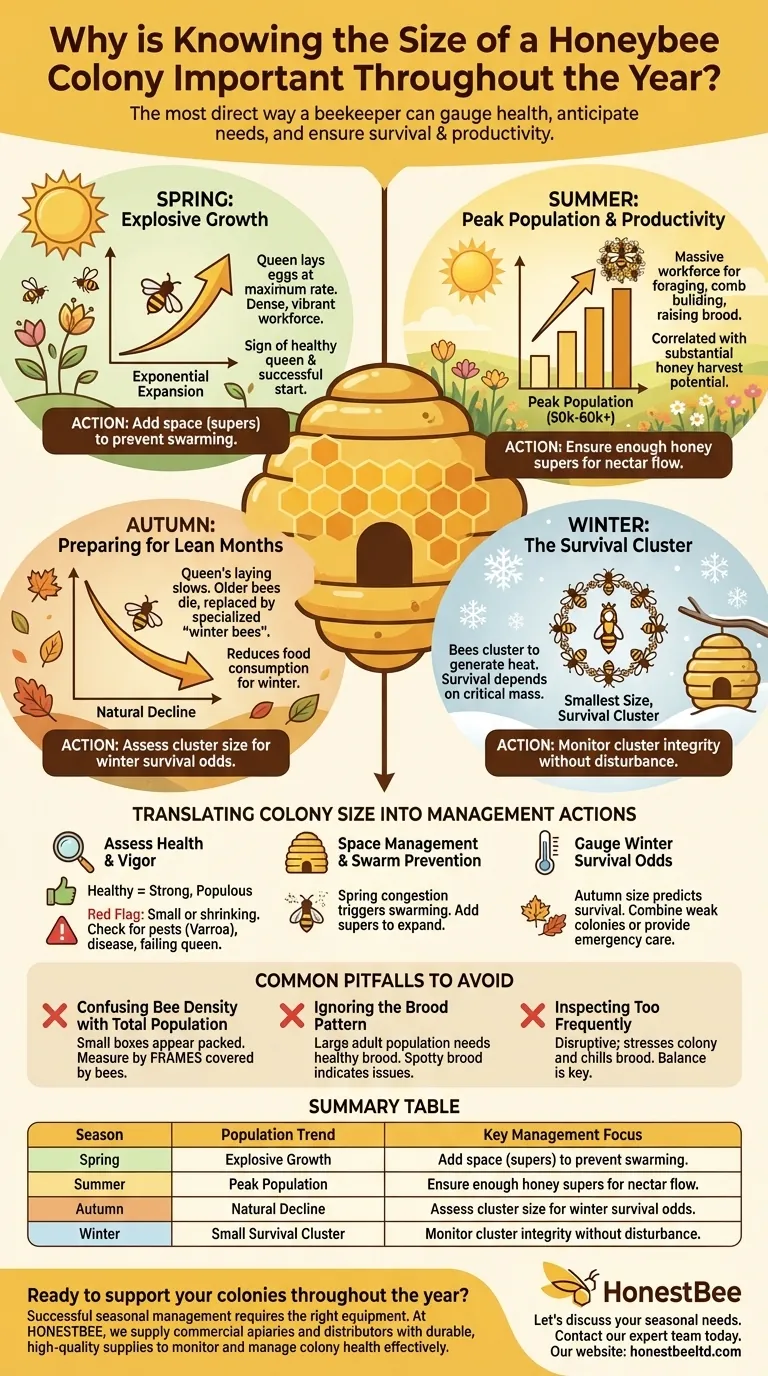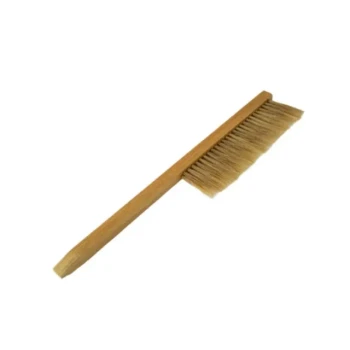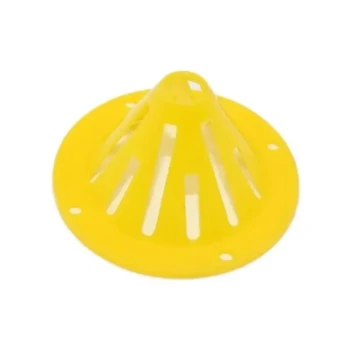At its core, knowing the size of a honeybee colony is the most direct way a beekeeper can gauge its health, anticipate its needs, and make timely decisions to ensure its survival and productivity. The population of a hive is not static; it ebbs and flows dramatically with the seasons, and each stage requires a different management approach.
A honeybee colony is a dynamic superorganism whose population size is the primary vital sign. Monitoring this vital sign allows a beekeeper to shift from simply reacting to problems to proactively managing the colony for success throughout the year.

The Seasonal Rhythms of a Colony
A colony's population fluctuates in a predictable annual cycle. Understanding this rhythm is the foundation of effective beekeeping, as it provides the context for every observation you make.
Spring: Explosive Growth
As days lengthen and nectar sources become available, the queen bee begins laying eggs at her maximum rate. The colony's population expands exponentially, creating a dense, vibrant workforce.
This rapid growth is a sign of a healthy, vigorous queen and a successful start to the season.
Summer: Peak Population and Productivity
By mid-summer, the colony reaches its peak population, which can exceed 50,000 to 60,000 bees. This massive workforce is dedicated to foraging, building comb, and raising the next generation.
A large summer population is directly correlated with the potential for a substantial honey harvest.
Autumn: Preparing for the Lean Months
As temperatures drop and forage becomes scarce, the queen's laying rate slows dramatically. The colony's population begins to shrink as older summer bees die off and are replaced by a smaller number of specialized "winter bees."
This decline is natural and necessary, as it reduces the colony's food consumption for the coming winter.
Winter: The Survival Cluster
The colony is at its smallest during the winter. The remaining bees form a tight cluster around the queen, vibrating their flight muscles to generate heat and keep the core temperature stable.
A colony's ability to survive the cold is entirely dependent on having a large enough population to form an effective cluster.
Translating Colony Size into Management Actions
Observing the colony's size is not a passive activity. It is data that directly informs critical, hands-on management decisions that can make or break a colony.
Assessing Colony Health and Vigor
A strong, populous colony is almost always a healthy one. Conversely, a colony that is small for the season, or one that is shrinking when it should be growing, is a major red flag.
This observation prompts an immediate investigation for problems like pests (Varroa mites), disease, or a failing queen.
Space Management and Swarm Prevention
In the spring, a rapidly growing population can quickly run out of space. This congestion is the primary trigger for swarming, where the old queen leaves with half the bees to find a new home.
By assessing the population density, a beekeeper knows when to add more boxes (supers), giving the colony room to expand and reducing the impulse to swarm.
Gauging Winter Survival Odds
A colony's size in the autumn is the single best predictor of its ability to survive winter. A small cluster cannot generate enough heat to withstand prolonged cold.
If a beekeeper notes a small population in the fall, they can take action by combining it with a stronger colony or providing emergency insulation and feed.
Common Pitfalls to Avoid
Simply looking at bees is not enough. Accurate assessment requires a nuanced understanding of what you're seeing to avoid critical misinterpretations.
Confusing Bee Density with Total Population
A small hive box can appear packed with bees, giving a false impression of strength. The key metric is the number of frames fully covered by bees, which provides a much more accurate estimate of the total workforce.
Ignoring the Brood Pattern
A large population is a good sign, but it must be supported by a healthy brood nest. A large number of adult bees with a spotty, unhealthy-looking brood pattern indicates an underlying problem, such as a failing queen or brood disease.
Inspecting Too Frequently
While monitoring is essential, opening the hive too often is disruptive. It stresses the colony, breaks the propolis seals they use to regulate their environment, and can chill the delicate brood. Balance is key.
Making the Right Decision for the Season
Your actions should be guided by the colony's size in the context of the time of year.
- If it's Early Spring: Your primary focus is assessing the rate of growth to add space proactively and prevent swarming.
- If it's Mid-Summer: Your primary focus is confirming a peak population to ensure you have enough honey supers on the hive to capture the nectar flow.
- If it's Late Autumn: Your primary focus is judging the absolute size of the pre-winter cluster to confirm the colony has the critical mass needed for survival.
- If a Colony is Stagnant or Declining (out of season): Your primary focus is an immediate investigation for disease, pests, or a queen issue.
Ultimately, tracking colony size transforms beekeeping from a reactive guessing game into a proactive and informed partnership with your bees.
Summary Table:
| Season | Population Trend | Key Management Focus |
|---|---|---|
| Spring | Explosive Growth | Add space (supers) to prevent swarming. |
| Summer | Peak Population | Ensure enough honey supers for nectar flow. |
| Autumn | Natural Decline | Assess cluster size for winter survival odds. |
| Winter | Small Survival Cluster | Monitor cluster integrity without disturbance. |
Ready to support your colonies throughout the year?
Successful seasonal management requires the right equipment. At HONESTBEE, we supply commercial apiaries and beekeeping equipment distributors with the durable, high-quality supplies needed to monitor and manage colony health effectively—from hive boxes and frames for spring expansion to wintering solutions for survival.
Let's discuss your seasonal needs. Contact our expert team today to ensure your operations are equipped for success.
Visual Guide

Related Products
- Classic Wooden Bee Brush with Double-Row Boar Bristles
- Professional Bee Frame Wiring Tool with Integrated Tensioning System by HONESTBEE
- Professional Long-Handled Silicone Honey Scraper for Beekeeping
- Wooden Bee Brush with Triple Row Artificial Fiber for Beekeeping
- Lightweight Durable Plastic Queen Excluder Scraper for Beekeeping
People Also Ask
- Why do beekeepers use a bee brush? The Essential Tool for Gentle Bee Handling
- Why is a bee brush important? Essential for Gentle, Safe Hive Management
- What is a bee brush used for? Gently Sweep Bees from Honeycomb Frames
- What is a bee brush and how is it used in beekeeping? A Guide to Gentle Bee Handling
- What are the key features of a popular bee brush? Essential Design for Bee Safety and Hive Hygiene



















